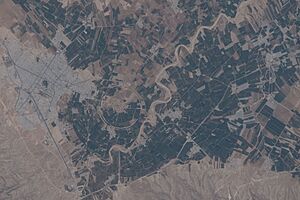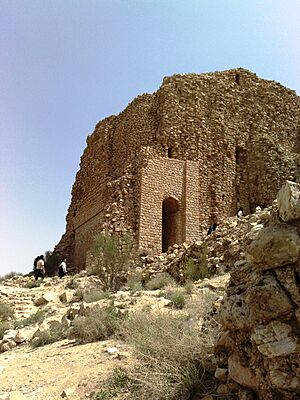Firuzabad, Fars facts for kids
Quick facts for kids
Firuzabad
Persian: فيروزآباد
|
|
|---|---|
|
City
|
|

Aerial photo of the modern town of Firuzabad and the ancient circular city of Gor nearby
|
|
| Country | Iran |
| Province | Fars |
| County | Firuzabad |
| District | Central |
| Elevation | 1,467 m (4,813 ft) |
| Population
(2016)
|
|
| • Total | 65,417 |
| Time zone | UTC+3:30 (IRST) |
Firuzabad (Persian: فيروزآباد) is a city in Iran. It is located in the Fars province, south of Shiraz. Firuzabad is the main city of its county and district. The city is surrounded by a mud wall and a ditch.
The original ancient city here was called Gor. It was built during the Achaemenid period. Alexander the Great destroyed it. Later, Ardashir I, who founded the Sassanid Empire, rebuilt the city. It was damaged again during the Arab Muslim invasion in the 600s. The city was rebuilt one more time by the Buyids. But it was finally left empty during the Qajar period. A new town grew up nearby, which is now modern Firuzabad. Today, the only part left of the old city is an ancient tower.
Contents
History of Firuzabad

The ancient city of Gor dates back to the Achaemenid time. This was a very old Persian empire. Gor was built in a low area. Because of this, Alexander the Great was able to flood the city. He did this by changing the path of a river during his invasion. The lake he created stayed there for a long time.
Rebuilding the City
Later, Ardashir I built a tunnel to drain the lake. He then built his new capital city on this same spot. Ardashir's new city was called Khor Ardashīr or Ardashīr Khurrah. It was also known as Gōr. The city had a perfectly round shape. It was so precise that a Persian historian wrote it looked like it was made with a compass.
The city was protected by a wide trench, about 50 meters (164 feet) across. The city itself was 2 kilometers (1.2 miles) wide. It had four gates. These were the Hormozd Gate in the north, the Ardashir Gate in the south, the Mithra Gate in the east, and the Wahram Gate in the west. The royal buildings were in the very center of the city. There was also a tall, spiral tower in the middle of town. It was 30 meters (98 feet) high and called Terbal. This design was special for Iran. Some people think it was an early version of the famous minaret in the Great Mosque of Samarra in Iraq.
Changes Over Time
Gor and another city, Istakhr, fought hard against the Arab Muslim invaders in the 630s and 640s. But they were eventually conquered in 649–50.
The city became important again when Fanna Khusraw of the Buyid dynasty ruled. He often lived in the city. This is when the old name Gōr was changed. In the language spoken then, Gōr (گور) meant "grave." King Adud al-Dawla, who was Fanna Khusraw's son, did not like living in a "grave." So, he ordered the city's name to be changed to Peroz-abad, which means "City of Victory." Since then, the city has been known by names like Firuzabad (فیروزآباد Fīrūzābād).
The old city was eventually left empty during the Qajar period. People moved to a nearby settlement, which is now the modern city of Firuzabad. It is about 3 kilometers (1.9 miles) east of the old Gor site. Today, you can visit the Sassanid Ghal'eh Dokhtar castle, the Palace of Ardeshir, and the fire temple in Firuzabad. You can also see the Minar from the old city.
Population and People
Population Numbers
In 2006, the city had about 58,210 people living in 12,888 homes. By 2011, the population grew to 64,969 people in 16,617 homes. The most recent count in 2016 showed 65,417 people living in 20,184 homes.
Groups of People
According to a study from 1939, about 7,000 Circassians lived in Firuzabad.
Climate
Firuzabad has a hot semi-arid climate. This means it is generally hot and dry, but it does get some rain.
| Climate data for Firuzabad (1991-2021), extremes (2009-2021) | |||||||||||||
|---|---|---|---|---|---|---|---|---|---|---|---|---|---|
| Month | Jan | Feb | Mar | Apr | May | Jun | Jul | Aug | Sep | Oct | Nov | Dec | Year |
| Record high °C (°F) | 25.2 (77.4) |
24.4 (75.9) |
28.8 (83.8) |
31.6 (88.9) |
38.2 (100.8) |
42.0 (107.6) |
42.7 (108.9) |
42.4 (108.3) |
39.6 (103.3) |
35.8 (96.4) |
31.6 (88.9) |
25.8 (78.4) |
42.7 (108.9) |
| Mean daily maximum °C (°F) | 12.1 (53.8) |
14.1 (57.4) |
18.8 (65.8) |
24.4 (75.9) |
31.3 (88.3) |
35.7 (96.3) |
36.9 (98.4) |
36.1 (97.0) |
32.8 (91.0) |
27.5 (81.5) |
19.2 (66.6) |
14.6 (58.3) |
25.3 (77.5) |
| Daily mean °C (°F) | 7.2 (45.0) |
9.2 (48.6) |
13.4 (56.1) |
18.9 (66.0) |
25.3 (77.5) |
29.3 (84.7) |
30.7 (87.3) |
29.8 (85.6) |
26.6 (79.9) |
21.7 (71.1) |
14.1 (57.4) |
9.5 (49.1) |
19.6 (67.4) |
| Mean daily minimum °C (°F) | 1.9 (35.4) |
3.5 (38.3) |
6.9 (44.4) |
12.0 (53.6) |
17.6 (63.7) |
21.3 (70.3) |
23.3 (73.9) |
22.2 (72.0) |
19.3 (66.7) |
14.9 (58.8) |
8.5 (47.3) |
4.0 (39.2) |
13.0 (55.3) |
| Record low °C (°F) | −2.0 (28.4) |
−5.2 (22.6) |
−2.0 (28.4) |
1.6 (34.9) |
6.6 (43.9) |
14.4 (57.9) |
19.4 (66.9) |
20.0 (68.0) |
16.4 (61.5) |
9.6 (49.3) |
1.4 (34.5) |
−0.2 (31.6) |
−5.2 (22.6) |
| Average precipitation mm (inches) | 76.8 (3.02) |
89.1 (3.51) |
35.9 (1.41) |
53.0 (2.09) |
11.5 (0.45) |
0.4 (0.02) |
2.2 (0.09) |
2.0 (0.08) |
1.9 (0.07) |
2.1 (0.08) |
32.4 (1.28) |
65.2 (2.57) |
372.5 (14.67) |
| Source: Normals [1], Extremes and precipitation [2] | |||||||||||||
Education
Firuzabad has several universities for higher education. These include:
- Firuzabad Higher Education University
- Islamic Azad University, Firuzabad Branch
- Payame Noor University, Firuzabad Center
- A branch of Technical and Vocational University
- A branch of University of Applied Science and Technology
See also
 In Spanish: Firuzabad para niños
In Spanish: Firuzabad para niños


